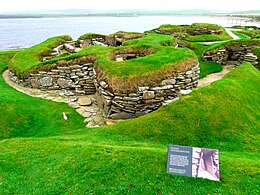Heart of Neolithic Orkney
World Heritage site in Orkney Islands, Scotland, UK
Heart of Neolithic Orkney refers to a group of Neolithic monuments found on Mainland, one of the islands of Orkney, Scotland. The name was adopted by UNESCO when it proclaimed these sites as a World Heritage Site in 1999.[1]
| UNESCO World Heritage Site | |
|---|---|
 Excavated dwellings at Skara Brae, Europe's most complete Neolithic village. | |
| Location | Orkney, United Kingdom |
| Includes | |
| Criteria | Cultural: (i), (ii), (iii), (iv) |
| Reference | 514bis |
| Inscription | 1999 (23rd Session) |
| Extensions | 2015 |
| Area | 15 ha (37 acres) |
| Buffer zone | 6,258 ha (15,460 acres) |
| Coordinates | 58°59′45.8″N 3°11′19.2″W / 58.996056°N 3.188667°W |

There are five sites on Mainland:
- Skara Brae – a cluster of ten houses making up Northern Europe’s best-preserved Neolithic village.[2]
- Ring of Brodgar – a stone circle 104 metres in diameter, originally composed of 60 stones set within a circular ditch up to 3 metres deep and 10 metres wide, forming a henge monument. It has been estimated that the structure took 80,000 man-hours to construct.[3][4]
- Standing stones of Stenness – the four remaining megaliths of a henge, the largest of which is 6 metres (19 ft) high.[4][5]
- Ness of Brodgar is an archaeological site between the Ring of Brodgar and the Stones of Stenness that has provided evidence of housing, decorated stone slabs, a massive stone wall with foundations, and a large building described as a Neolithic 'cathedral'.[6][7]
- Maeshowe – a unique chambered cairn and passage grave, aligned so that its central chamber is illuminated on the winter solstice. It was looted by Vikings who left one of the largest collection of runic inscriptions in the world.[8][9]
Related pages
changeReferences
change- ↑ UNESCO, "Heart of Neolithic Orkney". Retrieved 2012-4-19. Archived 2012-04-29 at the Wayback Machine
- ↑ "Skara Brae Prehistoric Village" Archived 2016-05-05 at the Wayback Machine Historic Scotland. Retrieved 16 August 2009.
- ↑ " The Ring o' Brodgar, Stenness" Archived 2017-07-15 at the Wayback Machine. Orkneyjar. Retrieved 16 September 2008.
- ↑ 4.0 4.1 Wickham-Jones, Caroline 2007. Orkney: a historical guide. Edinburgh: Birlinn, 28–29. ISBN 1-84158-596-3
- ↑ "The Standing Stones o' Stenness" Archived 2017-06-07 at the Wayback Machine. Orkneyjar. Retrieved 16 September 2008.
- ↑ Towrie, Sigurd (16 August 2007) "Stone wall hints at Neolithic spiritual barrier"Orkneyjar. Retrieved 17 September 2008. Archived 12 September 2008 at the Wayback Machine
- ↑ Ross, John and Hartley, David (14 August 2009) " 'Cathedral' as old as Stonehenge unearthed." Edinburgh. The Scotsman. Retrieved 16 August 2009.
- ↑ "Maeshowe" Archived 2017-06-16 at the Wayback Machine. Orkneyjar. Retrieved 11 February 2008.
- ↑ BBC program: { [1]

